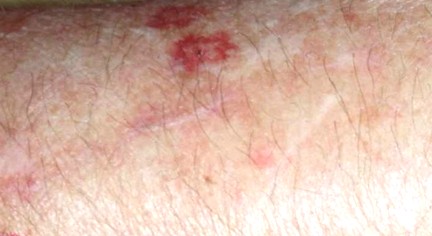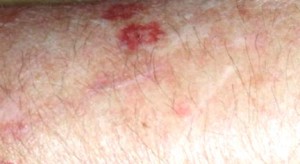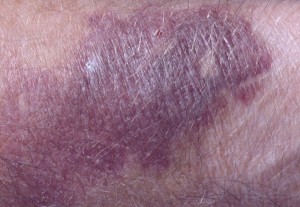Senile purpura is a prevalent non-cancerous condition marked by recurrent development of purplish bruises or ecchymoses on the extensor surface of the arms, usually after some kind of mild trauma.
Thomas Bateman, a British dermatologist, first described the condition in the year 1818. Hence, it is also referred to as Bateman purpura. Other popular names of the condition include blood spots, skin hemorrhages, and purpura senilis.
It may be noted that a condition marked by blood leakage from beneath the skin or from areas where tiny blood vessels connect together can be termed as purpura. The condition will typically occur as patches or spots on the skin, mucous membranes, and other organs. In the early stages, the bruises of senile purpura appear purplish red. The hemorrhagic spots may develop in varied sizes. Big purpura spots are known as ecchymoses, while small spots are known as petechiae.
Senile purpura occurs in both females and males, but is more common in those over the age of 50 years. As one ages, the skin becomes more delicate and thinner. The blood vessels in the skin also become fragile with age and hence bruises tend to occur easily in the elderly, especially on the legs and the forearms. Other factors which increase the vulnerability to developing senile purpura include use of blood thinners/anti-coagulants and/or corticosteroids as well as chronic exposure to the UV rays of sunlight. The condition does not occur due to any minerals or vitamin deficiency or some underlying bleeding ailment.
Symptoms of senile purpura
Senile purpura usually occurs in older adults as the blood vessels and dermal tissues become more fragile with age. Some of the common signs and symptoms of senile purpura are listed below:
- Patients may suffer from chronic and relapsing ecchymoses or irregularly-shaped lesions or macules with clear borders. They may measure about 1 to 4 cm diametrically and are dark purplish in color.
- The lesions often occur on the dorsal surface of the hands and the extensor aspect of the forearms. Occasionally, they may be distributed on the face and/or neck.
- Unlike a bruise which undergoes color changes, senile purpura lesions do not elicit any changes in color; they resolve on their own in about 3 weeks.
- The subcutaneous tissue and the skin in the affected region usually suffer from tearing, unusual thinning, and atrophy. Use of medications like warfarin, corticosteroids, and aspirin, etc. can worsen the senile purpura lesions.
- The adjacent skin may also experience unusual thinning, inelasticity, easy tearing, and pigmentation along with other signs of sun damage and aging skin.
- The abnormal patches generally occur a few days after some kind of blunt or minor trauma on the affected area.
- The senile purpura lesions tend to clear out on their own and yellowish stains or brown discoloration are left at the spot as reminders. Such discoloration occurs due to excess iron and/or hemosiderin deposits at the site of trauma. It may be permanent or may vanish over a period of many weeks or even months.
Causes
- Excessive exposure to UV radiation of the sunlight as well as the natural process of aging can thin the skin and also impair the connective tissues which contain blood vessels. Subsequently, the shallow vessels can rupture and tear with even minor trauma. The blood then leaks out into the nearby dermis layer of skin, eventually causing the formation of the dark purplish senile purpura patches on the skin.
- The persistent or permanent brown or dark discoloration of skin after the lesions have healed occurs due to deposits/buildup of iron and/or hemosiderin, a component of RBCs, at the affected area.
- Uncommonly, senile purpura may also be caused due to excessive use or abuse of aspirin, steroids, and other blood thinning medications. Diabetes and vascular diseases are other known causes of senile purpura.
- It is important to distinguish senile purpura lesions from low platelet count or thrombocytopenia, deficiency of vitamin C or scurvy, and connective tissue disorders.
- Thrombocytopenic purpura may develop due to causes such as idiopathic thrombocytopenic purpura, meningococcemia and other such infections, and use of drugs which hamper platelet functioning or prevent their formation.
- Non-thrombocytopenic purpura may be caused due to intake of medications which alter platelet functioning, underlying presence of blood clotting illnesses, changes in pressure associated with vaginal childbirth, congenital cytomegalovirus, fragile blood vessels, inflammation of blood vessels, vitamin C deficiency, hemangioma, use of steroids, and amyloidosis, i.e., a condition marked by buildup of amyloid proteins in the tissues.
Treatment
Senile purpura is a harmless condition that does not require any kind of treatment. The lesions tend to clear out on their own, without causing any health complications such as spread of the bleeding to other parts of the body.
Senile purpura is however a recurrent and persistent condition and patients may suffer from development of the lesions through the rest of their lives. Also, some patients may be at increased risk to skin tearing; such people need to seek medical attention.
- Patients may use sun-protection measures such as wearing hats, sunglasses, and sun-protective clothing as well as application of sunscreen when going outdoors. This will help limit or prevent future episodes of senile purpura.
- Easy bruising can be avoided via use of skin moisturizers. Use of flavonoids, vitamin C supplements, and other antioxidants can also help protect the skin.
Senile Purpura Pictures




Der hohe Aufwand zur Erstellung regelkonformer
neuer Blöcke begrenzt nicht nur die Rate der Neuemissionen, sondern erhöht auch den Aufwand, eine Fälschung zu erstellen.
Thông thường, ví lạnh phù hợp cho
nhà đầu tư dài hạn, ít khi phải giao dịch, vì mỗi lần giao dịch là khá tốn công.
Ok so I saw almost these exact same sandals at REI but they were Teva brand.
Накрутка Twitch Зрителей
It’s pretty distracting to see it go on and off, and wondering if it has any negative effects to the device itself.
This is not “easy” reading.
Notably, gambling was not legal in Britain at the outset.
These have a comfortable memory foam sole and I can wear them for longer periods of time than regular shoes or sneakers.
This Ԁesign is wicкed! You most certainlly know how to kewep a reader amused.
Betwren yoour wit and your videos, I was almost moed to start mmy own blog (well, almost…HaHa!)
Wojderful job. I really enjoyed what you had to say,
and more than that, hօw you presented it. Too cool!
My web blog; cheap cvv
Great post. I used to be checking continuously this blog and I’m impressed! Very useful information specially the ultimate part 🙂 I care for such info a lot. I was looking for this particular info for a long time. Thank you and best of luck. |
Would definitely recommend these headphones if you want an inexpensive headphone.
I wear these to work, wear them when i鈥檓 building my house and worn them on an adventure in utah.
My brother recommended I might like this website.
He was totally right. This post actually made my day.
You cann’t imagine simply how much time I had spent for this info!
Thanks!
Also visit my web-site – 홈카지노
Taxi Utrecht
Taxi Utrecht is een jonge en dynamische taxicentrale in Utrecht.
Wij zijn gespecialiseerd in het aanbieden van op maat
gemaakte services op het gebied van taxivervoer in en rondom Utrecht.
Taxi Utrecht
Wow! This blog looks just like my old one! It’s on a entirely different topic but it has pretty much the
same layout and design. Excellent choice of colors!
I read this piece of writing completely about the comparison of hottest and
preceding technologies, it’s amazing article.
https://comprarcialis5mg.org/cialis-5-mg-precio/
https://selah.cz/hound/s/r.php?r=https%3a%2f%2fcomprarcialis5mg.org%2Fcialis-5-mg-precio%2F
cialis 5 mg precio andorra https://comprarcialis5mg.org/cialis-5-mg-precio/
I couldn’t resist commenting. Perfectly written!
Jewell
http://v.miqiu.com/url/?url=https://www.eduvision.edu.pk/counseling/index.php?qa=user&qa_1=lachulgllb
http://lovecry.s4.xrea.com/cgi-bin/lotus/apeboard_plus.cgi?command=rea
Jewell (Wanda) http://www.bausch.com.ph/en/redirect/?url=https://torgi.gov.ru/forum/user/edit/1628640.page
Thank you for some other fantastic post. Where else may just anyone get that kind of information in such an ideal method of writing?
I’ve a presentation next week, and I am on the look for
such info.
Here is my web site :: 바카라 노하우
What’s Going down i am new to this, I stumbled upon this I’ve found
It positively useful and it has helped me out
loads. I hope to give a contribution & assist different customers like
its aided me. Good job.